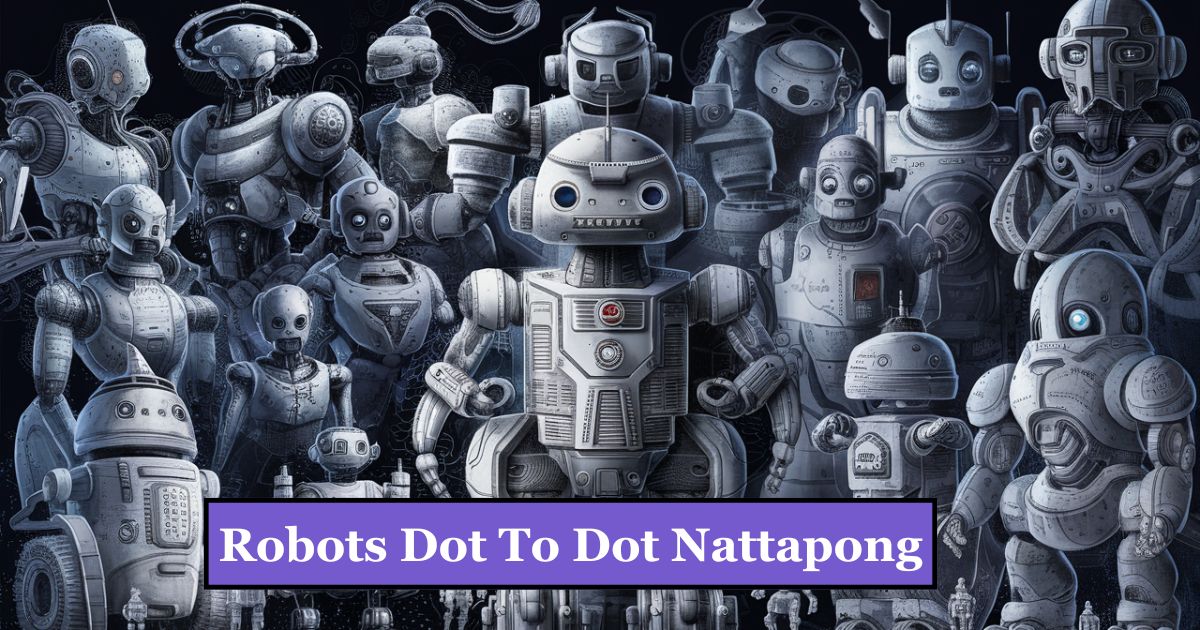In the ever-evolving digital age, robotics has become a cornerstone of technological advancement. Among the innovators shaping this field, one name stands out: Nattapong. His brainchild, Robots Dot to Dot Nattapong, is transforming how we approach robotics education.
This interactive robotics project isn’t just another educational tool; it’s a game-changer that’s bridging the knowledge gap and inspiring the next generation of tech enthusiasts.
Understanding “Robots Dot to Dot Nattapong”
Robots Dot to Dot Nattapong makes building robots as easy as connecting dots in a coloring book. It’s a clever way to learn robotics that even kids can understand. This fun system helps people of all ages create working robots step by step, just like solving a puzzle.
Concept Explanation
Imagine building a robot as easily as connecting dots in a children’s coloring book. That’s the genius behind Robots Dot to Dot Nattapong. This innovative approach simplifies complex robotics concepts, making them accessible to learners of all ages. It’s not just about following instructions; it’s about understanding the ‘why’ behind each step.
Nattapong, the visionary behind this project, recognized a critical need in STEM education. He saw that many students were intimidated by robotics, viewing it as too complex or out of reach. His solution? Break it down into manageable, interconnected steps – just like a dot-to-dot puzzle.
Historical Context
The journey of Robots Dot to Dot Nattapong began in the early 2010s when Nattapong, then a robotics engineer, volunteered at a local school. He noticed students struggling with traditional robotics kits and decided there had to be a better way. Drawing inspiration from childhood puzzle books, he developed the first prototype of his dot-to-dot robotics system.
Initially met with skepticism, Nattapong’s idea gained traction as educators saw its potential. Over the years, it evolved from a simple concept to a comprehensive educational system, incorporating AI integration and adapting to the growing Internet of Things (IoT) landscape.
Read Also More Post
Understanding the Issue of [Noblocc] Kicked for Being AFK in Block
Key Features
What sets Robots Dot to Dot Nattapong apart is its unique blend of simplicity and innovation. Here are some standout features:
- Step-by-Step Guidance: Each project is broken down into clear, manageable steps.
- Visual Learning: The dot-to-dot approach provides visual cues, making it easier for learners to understand spatial relationships.
- Scalable Difficulty: Projects range from beginner to advanced, growing with the learner’s skills.
- Integration with AI and IoT: Advanced projects introduce concepts of artificial intelligence and IoT, preparing students for future tech trends.
- Gender-Inclusive Design: The system is designed to appeal to all genders, promoting diversity in STEM fields.
Technical Breakdown

Hardware Components
The hardware in Robots Dot to Dot Nattapong kits is carefully curated to balance functionality with ease of use. Each kit typically includes:
- Microcontrollers (e.g., Arduino-compatible boards)
- Various sensors (light, sound, touch)
- Actuators (motors, servos)
- Structural components (custom-designed for easy assembly)
What makes these components special is their modular nature. They’re designed to connect easily, following the dot-to-dot principle. This design reduces frustration and allows learners to focus on understanding the function of each part.
Software Components
On the software side, Robots Dot to Dot Nattapong shines with its user-friendly interface. The programming environment is visual and intuitive, reminiscent of block-based coding languages like Scratch. However, it goes a step further by incorporating:
- Drag-and-drop functionality that mirrors the physical assembly process
- Real-time simulation to preview robot behavior
- Gradual introduction of text-based coding for advanced learners
This approach ensures that students not only build robots but also understand the logic behind their operations.
Integration of Hardware and Software
The magic of Robots Dot to Dot Nattapong lies in how seamlessly the hardware and software components work together. As learners connect the physical dots, they’re simultaneously building the software logic. This integration helps in:
- Visualizing abstract programming concepts
- Understanding cause-and-effect relationships in robotics
- Developing problem-solving skills through hands-on debugging
Building the Project

Step-by-Step Guide
Building a robot with Dot to Dot Nattapong is an adventure in itself. Here’s a glimpse into the process:
- Unboxing and Orientation: Each kit comes with a map-like guide, showing where each component ‘dot’ should go.
- Component Identification: Students learn to recognize different parts, understanding their functions.
- Assembly: Following the dot-to-dot pattern, learners connect components, seeing their robot take shape.
- Basic Programming: Using the visual interface, students program simple behaviors.
- Testing and Iteration: The robot comes to life, and students are encouraged to experiment and improve their design.
Coding the Project
Coding in Robots Dot to Dot Nattapong evolves with the learner. It starts with simple, visual programming and progresses to more complex coding concepts. For instance:
- Beginner Level: Drag-and-drop blocks to create basic movement patterns.
- Intermediate Level: Introduction to loops and conditionals through interactive challenges.
- Advanced Level: Text-based coding with Python or C++, integrated with the visual interface.
This gradual progression ensures that learners build confidence along with competence.
Testing and Calibration
A crucial part of the Robots Dot to Dot Nattapong experience is the testing phase. Students learn:
- How to systematically check each component
- The importance of calibration in robotics
- Troubleshooting techniques when things don’t work as expected
This phase is where true learning often happens, as students grapple with real-world engineering challenges.
Engaging Kids in Technology
Robots dot to dot nattapong is an excellent tool for introducing children to technology in a fun and engaging way. It transforms a simple dot-to-dot puzzle into a technological adventure, helping kids learn about sequencing, problem-solving, and creativity while fostering a lifelong interest in STEM.
The activity appeals to children through the element of surprise, as they anticipate revealing the hidden robot image. This sense of achievement boosts their confidence and motivates them to tackle more complex challenges. Parents can use robots dot to dot nattapong as a bonding activity, spending quality time with their children while nurturing their interest in technology in a pressure-free environment.
Applications and Use Cases
Educational Uses
In classrooms across the USA, Robots Dot to Dot Nattapong is revolutionizing STEM education. Teachers report increased engagement and improved understanding of complex concepts. For example, at Westview High School in San Diego, students used the system to create robots that could navigate a maze, integrating lessons from physics, mathematics, and computer science.
Entertainment and Art
Beyond education, these robots are making waves in entertainment and art. In New York City’s Maker Faire, a group of middle school students showcased a Dot to Dot Nattapong robot that could create abstract paintings, blending technology with creativity.
Future Prospects
The potential applications of Robots Dot to Dot Nattapong extend far beyond the classroom. Industry experts predict its principles could be applied in:
- Rapid prototyping for tech startups
- Simplified robotics training in manufacturing
- Accessible home automation projects
Expert Opinions and Insights

Interviews with Experts
Dr. Emily Chen, Professor of Robotics at MIT, says, “What Nattapong has created isn’t just a toy or a teaching tool. It’s a new way of thinking about robotics education that could shape the future of the field.”
Community Contributions
The Robots Dot to Dot Nattapong community is vibrant and growing. Online forums are filled with user-generated innovations, from solar-powered robots to AI-enhanced pet feeders. This collaborative spirit is driving the project forward in unexpected and exciting ways.
Read Also More
GUIDE TO ANIME:6TBZTSEKYF0= SUS
Resources and Further Reading
For those eager to dive deeper into the world of Robots Dot to Dot Nattapong, here are some valuable resources:
- “The Dot-to-Dot Revolution in Robotics” by Nattapong (available on Amazon)
- Online course: “Mastering Robots Dot to Dot” on Coursera
- Community forum: dotdotrobots.com
Summary
Robots Dot to Dot Nattapong is more than just an educational tool; it’s a movement that’s democratizing robotics education. By simplifying complex concepts and making robotics accessible to all, Nattapong has opened doors for countless students and hobbyists. As we look to the future, it’s clear that this innovative approach will continue to shape how we think about and interact with technology.












